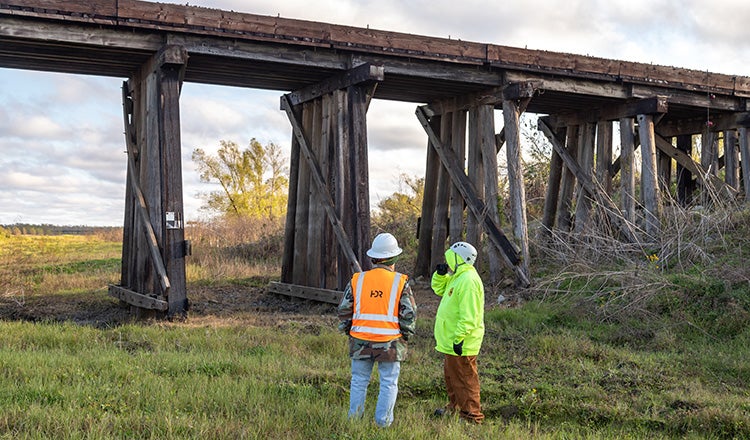Bonnet Carré Spillway Rail Bridge Reconstruction Environmental Services

Bonnet Carré Spillway Rail Bridge Reconstruction Environmental Services
Unearthing History and Replacing Important Freight Infrastructure
A Louisiana railroad bridge that serves as part of a major freight artery is set for an upgrade — and in the process, our team is helping to uncover the history of the area.
The bridge is located near Norco, in St. Charles Parish, Louisiana, about 20 miles west of New Orleans. It’s a timber trestle bridge that was built in the 1930s, when the Bonnet Carré Spillway was constructed.
Our team is providing a variety of regulatory review and permitting services to owner Illinois Central Railroad Company, including environmental data collection, a preliminary impact assessment, utilities research, alternatives analysis, hydrology and hydraulics analysis, geotechnical reviews, cultural resources research and the development of a draft joint permit application and Section 408 review application.
The plan is to replace the existing 8,000‐foot‐long, 601-span ballasted timber trestle bridge with prestressed, precast concrete double voided box girders, supported on new, precast concrete piers and abutment caps on steel H‐piles. The proposed bridge will be approximately 7,948 feet from backwall to backwall.
As part of the project, our cultural resources team delved into the history of the area. The first task was to determine whether the bridge itself had historical significance that merited preservation. Once that was accomplished and the bridge was not found to have historical significance, HDR’s archeologists and historians turned to a much more mysterious issue: a possible Civil War-era Union cemetery that was an unexpected wrinkle in the project plans.

Sensitive Cemetery Site
The U.S. Army Corps of Engineers had documented a potential burial site of Union soldiers stationed in the Bonnet Carré area in the 1860s. While it was known that a Union regiment camped near what is now the project site, and that there was a cemetery somewhere in the area, there was not much indication of where the cemetery was. If human remains were on the project site, they would either need to be avoided or excavated before construction began.
Then the Army Corps was made aware of an oral report from the 1980s. An 89-year-old man said at the time that his grandfather had told him that there was a cemetery in the area of the bridge. Written records do not indicate any cemetery in the area, and if one does exist, the lack of records could indicate buried soldiers were from a Black regiment — giving the issue additional equity implications.
Excavating the entire site for human remains would cost six figures and delay the project. So HDR’s cultural resources team proposed a less-invasive, cutting-edge solution: using a gradiometer, which detects anomalies in the magnetic field below ground, and ground-penetrating radar in combination with dogs that are specially trained to detect even very old human remains.
After the investigation from two Labradors, two border collies, the gradiometer and radar, our team concluded that there was not a cemetery on the project site. The dogs did detect odor from beyond the project area, meaning that an undiscovered cemetery could be in the area. But the spillway bridge project was able to move forward without budgetary or schedule disruption.
Construction is scheduled to begin in 2022 and take about two years.








